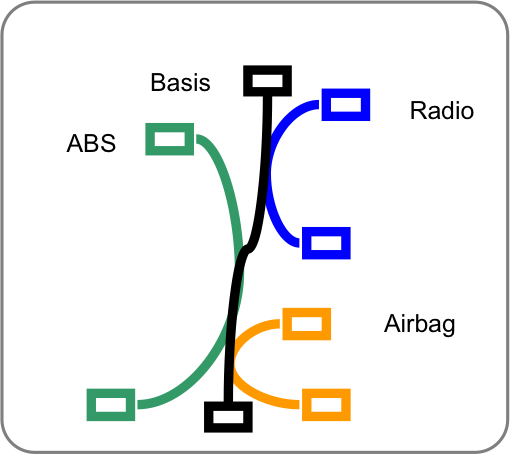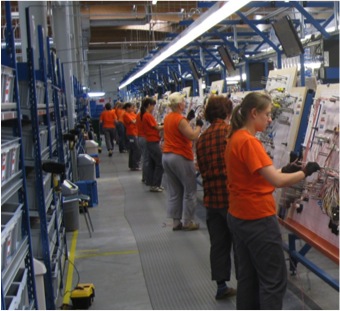Customised Cable Harness - KSK
KSK – The Principle
Some automotive manufacturers in Germany already established the so called KSK i.e. “customised wiring harness (loom)”. Each KSK is used in a specific car and covers exactly all required electrical features of this car.
As a result there are no redundant electrical connections (not required wires) which cause product cost advantages. On the other hand the KSK-concept requires specific solutions concerning development, logistics, engineering, production, testing, change management, accounting and IT systems.
There are as well KSKs used in commercial vehicles e.g. cockpit or chassis wiring harnesses. The commercial vehicle KSKs are not only customised regarding electrical features, but also regarding geometrical layout i.e. wire lengths.
As a result there are no redundant electrical connections (not required wires) which cause product cost advantages. On the other hand the KSK-concept requires specific solutions concerning development, logistics, engineering, production, testing, change management, accounting and IT systems.
There are as well KSKs used in commercial vehicles e.g. cockpit or chassis wiring harnesses. The commercial vehicle KSKs are not only customised regarding electrical features, but also regarding geometrical layout i.e. wire lengths.

KSK – The Concept
The KSK concept includes the following elements:
Development:
Development:
A KSK-drawing shows the topology (geometry) and all possible electrical features of the wiring harness. It is called a 150%-drawing. A KSK of a specific car uses only a subset of this drawing (100%-drawing) and all available electrical features. A KSK, e.g. the cockpit-KSK, consists of several hundreds of electrical connections.
Logistics:
Each KSK matches one specific car. Therefore the KSKs needs to be delivered to the OEM with a Just-in-Time-process (JIT) or even a Just-in-Sequence-process (JIS). On the one hand the OEM communicates a long term forecast of all required electrical modules to the KSK-supplier and on the other hand short term KSK-orders which describe the car-related electrical modules and the JIT-/JIS-delivery date. Important logistic aspects are
- KSK-order-immutability (order content)
- KSK-order time schedule
- KSK-order-package-immutability (frozen zone)
Engineering:
The supplier-engineering focuses on creating suitable data and documents for KSK production and KSK reviews. Depending on the production concept the engineering uses the electrical customer modules or internal production modules (subset or combination of customer modules). There are static and dynamic production modules which are formed on customer's orders.
Production:
In most cases the final assembly is done by means of assembly lines, each with several interlinked work stations.
The design of each KSK is different e.g. the number of wires. This causes as well different workloads at the work stations in the assembly line.
Therefore a key success factor represents a good line balancing i.e. a convenient relation of work packages and work stations to ensure high assembly line efficiency.
The design of each KSK is different e.g. the number of wires. This causes as well different workloads at the work stations in the assembly line.
Therefore a key success factor represents a good line balancing i.e. a convenient relation of work packages and work stations to ensure high assembly line efficiency.

Review:
Each KSK matches one specific car and so is almost unique. As a result the electrical review systems need to create unique KSK-electrical review routines. Optical review systems as well need to create unique KSK-review routines concerning fuse- and relay tests.
Technical change management:
Technical changes affect the topology (geometry) and / or the electrical features of the wiring harness. One single technical change may simultaneously affect different electrical features and become valid for delivery at a certain point of time. This is why it's essential to coordinate the production of new module versions in different production areas to ensure that the final wiring harness matches a certain technical status.
Accounting:
The accounting ususally is based on specific customer module prices. This customer module price covers the supplier's production costs of this module and as well the costs for final assembly.
IT-Systems:
The KSK-concept requires specific IT-solutions for:
- Development of a 150%-drawing
- Running the JIT/JIs-process based on KSK-orders and KSK-signals
- Creating production modules by means of KSK-customer modules
- Engineering of KSK-specific production equipment
- Production controlling of final KSK-assembly and KSK-preassembly
- Performing KSK-specific reviews



